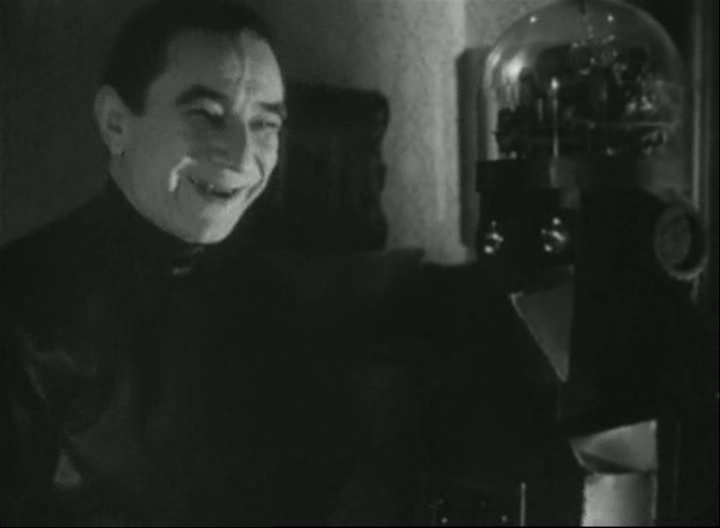
Arthur Lucan is the ne plus ultra of Awful British Comedians, or I hope he is. As Old Mother Riley, a shrieking, gesticulating Irish char lady, he appeared in a series of poverty row productions, generally with his wife, Kitty O’Shea, playing his daughter. The sex lives of British comedians are best left unimagined — the little we know of them is repulsive — but the coition of Mr And Mrs Lucan reaches a level of gruesomeness unrivalled until the appearance of the Krankies (don’t Google — if you are in ignorance, best remain so). This may be why young Ken Russell regarded them with such abhorrence, but he doesn’t really need an excuse beyond what’s onscreen.
Kitty does not appear in MOTHER RILEY MEETS THE VAMPIRE, but Bela Lugosi does. He made this the same year as BELA LUGOSI MEETS A BROOKLYN GORILLA, and it’s a wonder he survived, even if not for long. It’s hard to say which cinematic encounter depleted him more, but one thing you can say about Bela, he never phones it in. One might wish he had, from across the Atlantic, saving himself the trip and indignity.

Lucan doesn’t exactly spare us anything either, shrieking every line and waving his bony arms about in a pugilistic mania. Aware that his is a quickly overplayed hand and an entire film of this grisly schtick would turn the strongest stomach, the filmmakers provide a few less rabid actors for us to gaze upon, and two of these, the excellent and resourceful Dora Bryan and the ineffectual Richard Wattis, get what laughs are to be had.


But there are such things as anti-laughs, and when you tot everything up it’s clear that MRMTV has a net total of minus a thousand or so laughs. Despite feature a nice clanky robot, and some good weird sidekicks for Bela, including Judith Furse — the mannish Sister Briony from BLACK NARCISSUS and the ubermannish Doctor Crow from CARRY ON SPYING, assisted by bespectacled homunculus Ian Wilson. Some men are small. Some are very small. Wilson is unpleasantly small, he’s able to turn his stature into a creep factor, an impressive trick unequalled until Ronnie Corbett’s clockwork Nazi in CASINO ROYALE.


“Directing” the show is John Gilling, his Hammer films still ahead of him but with one Todd Slaughter script (THE GREED OF WILLIAM HART) to his name. Most of the men handed megaphones on Awful British Comedian movies have an anti-talent for comedy, but few compare with Gilling, who racks up the anti-laughs until whatever the opposite of hysteria is sets in. He has a way of suddenly cutting to a chiaroscuro closeup of his gurning lead clown that’s more authentically blood-curdling than anything he managed with reptile women, zombies, or pharaonic revenants. A full critical reckoning with Gilling has yet to occur, I feel. His Hammer films feel better than some of their rivals, but they’re funny, not scary. And his comedies are alarming, not funny. This being a horror comedy, it gets to be unfunny at all times, and the music-hall low-jinks are more alarming than the horror spoofery.

If you feel that you might be getting to be too happy, I can highly recommend this film. Image by image, it has a certain misguided verve, the mock-horror framing shows some ability. But put together, it’s absolutely lethal.

Verdict: Arthur Lucan and Old Mother Riley are both Awful. Lucan clearly has some kind of talent, but it could probably have been better applied to a career in enhanced interrogation techniques.









